In-Depth Analysis of Stink Bugs: Biology, Behavior, and Management
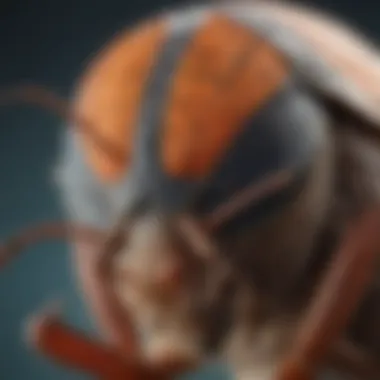
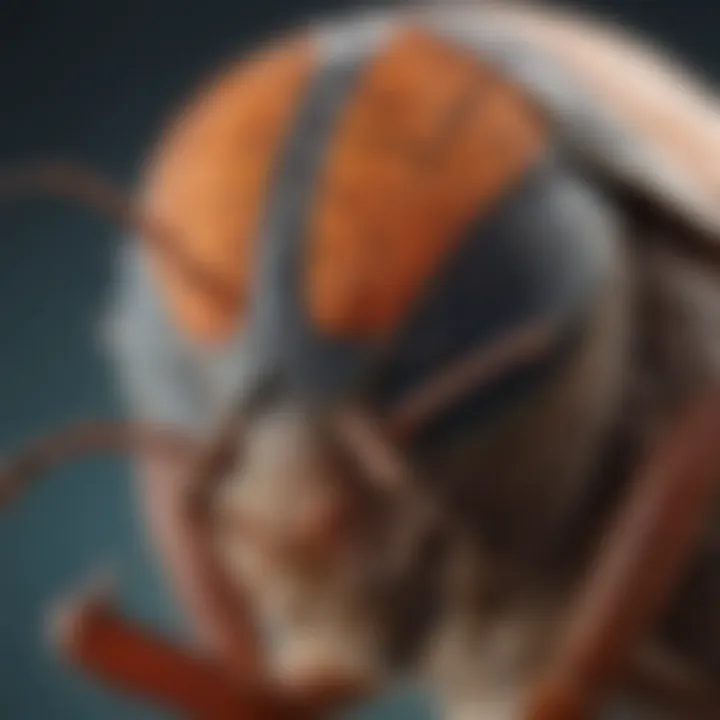
Intro
Stink bugs have garnered attention due to their rising populations and significant impact on agriculture. Understanding their biology and behavior is essential for effective management. This article provides insights into their defining characteristics, ecological roles, and the challenges they present to farmers. The content is structured to offer practical information, aiding in the development of effective pest management strategies.
Topic Overview
Definition and Importance
Stink bugs are a group of insects belonging to the family Pentatomidae. They are characterized by their shield-like body shape and the distinct odor they release when threatened. Their diet primarily consists of plant material, making them a notable pest in agriculture. The brown marmorated stink bug and the green stink bug are the most common species affecting crops in various regions.
Their presence can lead to significant economic damage. For instance, they can feed on fruits, vegetables, and other valuable crops, causing blemishes and reducing marketability. Understanding stink bugs is crucial for farmers and agricultural enthusiasts who aim to protect their harvests from these pests.
Brief History and Evolution
Historically, stink bugs have coexisted with humans for centuries. Their evolution has led to various adaptations that enable them to thrive in different environments. The introduction of the brown marmorated stink bug from Asia in the late 20th century marked a turning point for North American agriculture. They adapted quickly, leading to widespread infestations and prompting much research into management practices.
Key Techniques and Innovations
Sustainable Farming Practices
In recent years, sustainable farming practices have been emphasized to manage stink bug populations. These practices include crop rotation and polyculture, which help disrupt the life cycle of stink bugs.
- Use of pest-resistant crops: Selecting varieties that are resistant to stink bug infestations can mitigate damage.
- Beneficial insects: Introducing natural predators like parasitic wasps can help control stink bug populations.
Implementing these sustainable strategies can contribute significantly to reducing reliance on chemical insecticides, promoting a healthier ecosystem.
Advanced Agronomic Technologies
The integration of technology into agriculture has opened new avenues for managing pests, including stink bugs. Technologies such as infrared sensors and drone surveillance can detect early signs of infestations, allowing for timely intervention. These methods can provide farmers with invaluable data about crop health, enhancing decision-making processes.
Practical Applications
Step-by-Step Guides
Managing stink bugs requires a strategic approach. Here is a basic step-by-step guide:
- Identify infestations early through regular inspections.
- Evaluate the extent of the damage to determine the need for intervention.
- Implement integrated pest management techniques, focusing on biological and cultural practices.
- Monitor results and adjust strategies as necessary to ensure effectiveness.
Case Studies or Real-World Examples
Many farmers have successfully mitigated stink bug issues through innovative practices. For example, a case study from Virginia showcased a farm that utilized intercropping with sunflowers to distract stink bugs from economically important crops. This tactic resulted in reduced damage and increased yield.
"Adaptation and knowledge are our best tools in combating environmental challenges such as pest infestations."
Preamble to Stink Bugs
Understanding stink bugs is essential not only for agricultural professionals but also for anyone involved in gardening and environmental management. These insects, known for their characteristic odor, have distinctive biological traits that affect their behavior and ecological roles. This introduction sets the stage for a comprehensive examination of stink bugs, making it crucial to delineate their definition and their importance within ecosystems.
Definition and Overview
Stink bugs belong to the family Pentatomidae, which includes over 200 species. They are named for the pungent aroma they emit when threatened. The most common species include the brown marmorated stink bug and the green stink bug, both of which have significant agricultural implications. Stink bugs are identified by their flattened bodies, which can be greenish, brown, or gray, and their distinctively shaped antennae. These features help in recognizing them in the field, serving as a basis for further studies on their behavior and impact.
Importance in Ecosystems
Stink bugs play a multifaceted role in ecosystems. They are not simply pests; they also contribute to the food web. Predators like birds and certain insects rely on them as a food source. Their feeding habits can influence plant health, particularly when they infest crops. A decline in plant vigor due to their feeding can lead to larger ecological consequences, affecting various species that depend on those plants for survival.
"Stink bugs are integral to food webs, and understanding their biology can inform conservation efforts."
Agriculture relies heavily on a balanced ecosystem, where the presence of stink bugs impacts both crop yield and pest management strategies. Thus, knowing the importance these insects have in the environment allows farmers to adopt more informed and effective management practices.
Biological Characteristics
Understanding the biological characteristics of stink bugs is crucial for several reasons. First, this knowledge helps in their identification, which is key for any management strategy. Knowing their life cycle and behavior also allows farmers and agricultural enthusiasts to implement timely interventions. Furthermore, details about their taxonomy provide insights into potential pest variations and their unique adaptations in different environments. The biological framework discussed here lays the groundwork for more effective management and control strategies.
Taxonomy and Classification
Stink bugs belong to the family Pentatomidae and are classified under the order Hemiptera. Within this broad classification, they can be broken down into several genera and species. The most commonly known species is the brown marmorated stink bug (Halyomorpha halys), which has gained attention due to its agricultural impact.
The taxonomy reflects not only physical characteristics but also behavioral traits and ecological roles. Understanding these classifications aids in ecological monitoring and pest management. Each species may have specific behaviors that influence its effectiveness as a pest.
Physical Description
Size and Shape
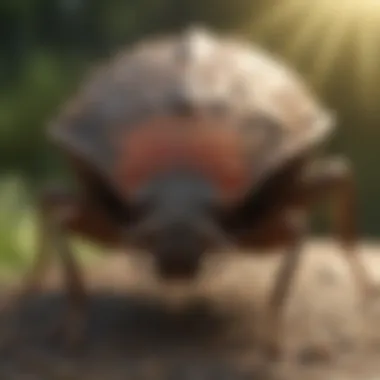
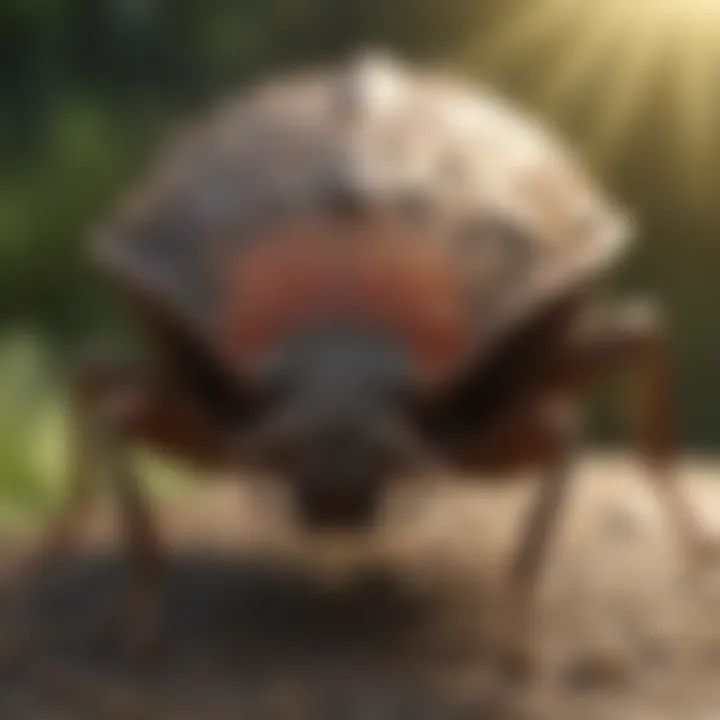
The size of stink bugs varies between species, but they generally measure between 1/2 inch to more than 1 inch in length. Their shape is commonly described as broadly oval to shield-like. This shape can be seen as advantageous because it enables the bugs to blend into their environment, making them less visible to predators. Additionally, these physical dimensions allow for ease of movement among host plants, facilitating feeding and reproduction.
A notable characteristic about their shape is the distinctive edges of their bodies, which can help in recognizing different species. Some species have evolved to have a more pronounced rounded shape, which may aid in defensive behaviors or camouflage.
Color Variations
Stink bugs are known for their diverse color variations. Common colors include green, brown, and black, with some featuring more intricate patterns. These color variations serve multiple purposes, including camouflage and temperature regulation. In the context of agriculture, recognizing these color patterns is essential for identifying specific species and understanding their impact on crops.
A unique feature of certain species is their vibrant coloration during mating seasons, which can attract mates. However, these colors may also signal danger to potential predators, thus enhancing their survival in the wild.
Life Cycle
The life cycle of stink bugs is comprised of several stages: egg, nymph, and adult. Understanding these stages is vital because each has different vulnerabilities and behaviors that affect crop management strategies.
Egg Stage
Stink bugs lay their eggs in clusters on the undersides of leaves, primarily during the warmer seasons. The eggs are small and typically green or yellowish in color. The egg stage lasts for about a week and is crucial, as it determines the population size for that season. Knowing the breeding habits and potential breeding areas helps in the early identification of infestations.
A significant characteristic of the egg stage is the aggregation of eggs, which may lead to rapid population increases if not controlled early on. Effective monitoring and identification practices in this stage can prevent extensive damage.
Nymph Stage
After hatching, stink bugs enter the nymph stage, characterized by rapid growth and molting. During this stage, they resemble miniature adults but lack fully developed wings. This stage lasts for several weeks, and the nymphs are especially aggressive feeders, causing significant damage to crops.
A critical aspect of the nymph stage is its potential for causing crop damage. Farmers must be vigilant during this time, as nymphs feed on plant sap, leading to wilting, yellowing, and even death of the plants.
Adult Stage
Stink bugs mature into adults after several molts, typically around five to seven weeks after hatching. Adult stink bugs are responsible for reproduction and can contribute to the continued infestation in crops. Their mobility aids in spreading between different host plants, elevating their potential harm.
A key characteristic of adult stink bugs is their ability to fly, enhancing their search for food. However, they become less effective feeders after mating, which can result in variations in crop damage if populations are not controlled. Being aware of adult behaviors can inform pest management strategies, especially in agricultural settings.
Behavioral Patterns
Understanding the behavioral patterns of stink bugs is crucial for several reasons. These patterns not only provide insight into their survival strategies but also highlight their potential impact on agriculture. By analyzing their behaviors, one can implement more effective management techniques. Moreover, recognizing these patterns assists farmers in predicting infestations and mitigating crop damage.
Feeding Habits
Host Plants
Host plants are significant in the life cycle of stink bugs. These insects are known to target a variety of plants, with specific preferences based on species. For instance, the brown marmorated stink bug primarily feeds on fruit trees, vegetables, and ornamental plants. This is a key characteristic, as understanding these preferences enables better management of stink bug populations. The threat they pose to crops cannot be overlooked.
The unique feature of host plants is their ability to sustain stink bug populations. They thrive on plants like tomatoes, soybeans, and apples. With these plants being beneficial crop choices, they are often attractive to stink bugs. However, this relationship poses a disadvantage; extensive feeding can lead to significant damage, impacting yield and quality.
Feeding Techniques
Feeding techniques play a major role in how stink bugs interact with their environment. Stink bugs utilize their piercing mouthparts to extract sap, causing teticular damage to plants.
Their feeding technique is efficient, allowing them to consume large amounts of plant fluids. This is another key characteristic, as these methods directly contribute to their success as pests. Different species of stink bugs have adapted unique feeding techniques that are suited to specific host plants.
A unique feature of these feeding techniques is the rapid feeding they can perform, leading to immediate plant stress. While their efficiency provides an advantage, it can also lead to severe agricultural loss. Thus, understanding these techniques is essential for effective management and control.
Mating and Reproduction
Mating Rituals
Mating rituals in stink bugs are complex and vary by species. These behaviors are essential for successful reproduction. Male stink bugs often perform courtship displays that involve specific movements and chemical signals to attract females. This key characteristic of mating ensures genetic diversity and enhances the survival of their offspring.
The unique feature of their mating rituals is the synchronization observed during the courtship. This can result in mass mating during specific periods, enhancing the chances of successful reproductive outcomes. However, factors such as environmental stress can disrupt these behaviors, impacting population sustainability.
Egg Laying
Egg laying is a critical phase in the stink bug life cycle. Females typically lay eggs on the underside of leaves to protect them from predators. This behavior is a strategic choice, reflecting a strong key characteristic in ensuring the survival of their young. The eggs are laid in clusters, which can be detrimental once detected by farmers.
A notable aspect of egg laying is the influence of environmental conditions. Optimal temperatures and the availability of host plants will affect where and how many eggs are laid. This feature plays a dual role; while it maximizes the chances of hatching in a suitable environment, it can also lead to localized infestations if conditions remain favorable.
Ecological Impact
The ecological impact of stink bugs is a significant topic in understanding their role within various environments. Stink bugs are not just mere pests; they have complex interactions with ecosystems that dictate both positive and negative effects. Their presence can alter plant dynamics and influence insect populations, providing insight into how these bugs fit into food webs.
Role in Food Webs
Stink bugs are integral components of the food webs in which they exist. They serve as both predators and prey, contributing to the balance in their ecosystems. As herbivores, stink bugs feed on a variety of plants, which can impact vegetation structure and health. However, they also provide sustenance to numerous predators. Birds, spiders, and other beneficial insects rely on stink bugs as a food source.
Understanding the role of stink bugs in food webs is essential for ecological research and agricultural practices. Their dual role can lead to a deeper comprehension of ecosystem dynamics.
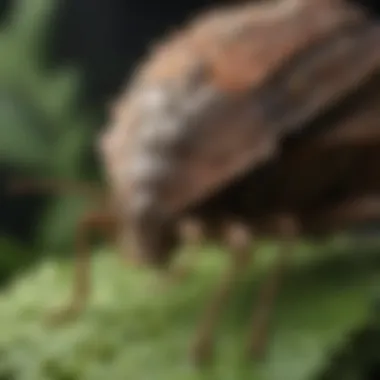
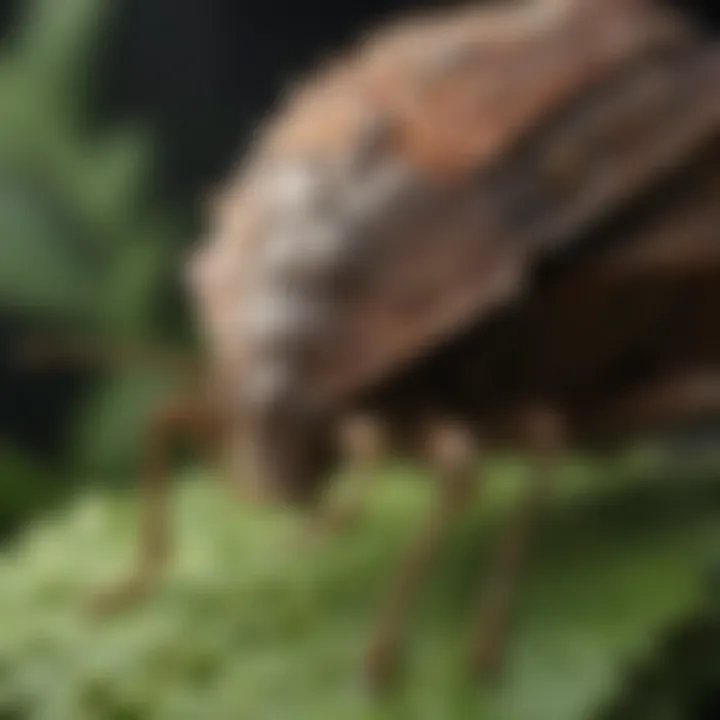
Impact on Agriculture and Horticulture
The impact of stink bugs on agriculture and horticulture is notable and multifaceted. Their feeding habits can result in substantial crop damage, affecting farmers' yields and profits.
Crop Damage
Stink bugs cause damage primarily through their feeding. They pierce plant tissues and withdraw sap, which can lead to wilting, yellowing, or even death of plants. Crops like soybeans, tomatoes, and apples are particularly vulnerable to their attacks. The key characteristic of this damage lies in the direct loss of crop quality and quantity.
The unique feature of crop damage by stink bugs is that it can go unnoticed initially, making early detection critical. In some cases, it becomes a major challenge for growers as infestations can multiply quickly. This increases the urgency for effective management strategies, making it a focal point in this article.
Economic Effects
The economic effects of stink bug infestations can be severe, impacting farmers’ incomes and the agricultural economy as a whole. When stink bugs damage crops, this can lead to reduced yields and higher production costs, creating a ripple effect throughout the supply chain. The key characteristic here is the financial burden placed on farmers, which often includes added expenses from pest management solutions and potential loss of sales due to reduced crop quality.
Additionally, the unique economic feature of these effects is the potential for increased prices on the market due to reduced supply, which can affect consumer prices. As such, understanding the economic implications of stink bug infestations is crucial for farmers and stakeholders in the agricultural industry.
Identification of Stink Bug Species
Identifying stink bug species is fundamental for farmers and enthusiasts alike. Knowledge of different species aids in understanding behavior, ecological impacts, and effective management strategies. Stink bugs can cause significant damage to crops, and recognizing the specific species involved allows for tailored approaches in pest control. This section will elaborate on common species found in agricultural settings and their distinguishing characteristics.
Common Species in Agriculture
Stink bugs are categorized into numerous species, but several are notably prevalent in agricultural environments:
- Brown Marmorated Stink Bug (Halyomorpha halys): This species is recognized for its brown color, and it poses a severe threat to various crops, including fruits and vegetables. Its adaptability has enabled it to spread across regions.
- Green Stink Bug (Chinavia hilaris): Characterized by its bright green color, this species primarily affects soybean, cotton, and other agricultural crops. It can be identified by its distinct appearance.
- Southern Green Stink Bug (Nezara viridula): Similar to the green stink bug, the southern green stink bug is known for its ability to damage a wide range of vegetation. Its presence is often recorded in bean and pepper crops.
Understanding these common species is crucial for early detection and management. Being informed can greatly influence crop yield and economic viability.
Distinguishing Features
Distinguishing stink bug species requires attention to detail. The following features are essential for identifying them:
- Coloration: Different species display various colors, such as brown, green, or even a mix. These characteristics often reflect their environment.
- Shape and Size: Stink bugs have a shield-like shape. The size can vary, but most are about half an inch long.
- Markings: Some species have distinctive markings on their shells. For example, the brown marmorated stink bug has white bands on its antennae.
- Behavior: Observing feeding habits and mating behaviors can also help differentiate species. Some prefer specific host plants, influencing their ecological role.
Understanding these distinguishing features not only aids in identification but also assists in implementing appropriate control measures.
In summary, accurately identifying stink bug species is a foundational aspect of effective management. The focus on common species and their distinguishing traits provides farmers and enthusiasts with the knowledge needed to protect their crops. Adapting management strategies based on species identification can mitigate damage and enhance agricultural sustainability.
Management and Control Strategies
In the context of stink bugs, effective management and control strategies are essential for minimizing their negative impact on agriculture. These pests are notorious for their ability to damage crops, leading to significant economic losses. Therefore, a proactive approach, incorporating various management techniques, is critical. These strategies not only help in controlling stink bug populations but also reduce the reliance on chemical solutions, ultimately ensuring sustainable farming practices.
Preventive Measures
Preventive measures serve as the first line of defense against stink bug infestations. Simple actions can significantly reduce the likelihood of these pests making an appearance. Key strategies include:
- Regular monitoring of crops and surrounding areas to identify early signs of stink bugs.
- Sealing entry points in homes and agricultural buildings to prevent stink bugs from finding shelter.
- Proper sanitation, such as removing debris and fallen fruit that may attract these pests.
Implementing these preventive measures not only keeps stink bug numbers low but also enhances overall crop health, making it harder for these pests to thrive.
Cultural Controls
Cultural controls focus on modifying agricultural practices to deter stink bugs. By altering the environment, farmers can make their crops less attractive to these pests. Some significant cultural control tactics include:
- Crop rotation to disrupt the life cycle of stink bugs.
- Planting resistant crop varieties, which can reduce the likelihood of pest damage.
- Implementing proper irrigation practices to minimize water stress on plants.
Such strategies can lower the crop’s susceptibility to infestations by creating less favorable conditions for stink bugs.
Mechanical Controls
Mechanical controls involve physical methods to manage stink bug populations. These strategies provide immediate results and can be implemented in various settings.
Traps
Traps are a well-known mechanical control method. They are designed to capture stink bugs, thereby reducing their numbers. The main advantage of traps is their non-toxic nature, making them safe for use in homes and around crops. A key characteristic of effective traps is their attractant, which lures stink bugs into the device.
However, one disadvantage is that they primarily catch a limited number of pests, potentially requiring multiple traps for large infestations. Nonetheless, they provide an immediate solution for monitoring and controlling populations.
Manual Removal
Manual removal is another mechanical control method that involves physically capturing stink bugs. This technique includes techniques such as handpicking bugs off plants and using vacuum cleaners.
One of the main advantages of manual removal is that it is environmentally friendly, having no harmful effects on surrounding wildlife or plants. It is a practical option for small infestations. Yet, the method can be time-consuming and labor-intensive, particularly in larger fields. Thus, it is often considered suitable for small gardens or localized infestations only.
Chemical Controls
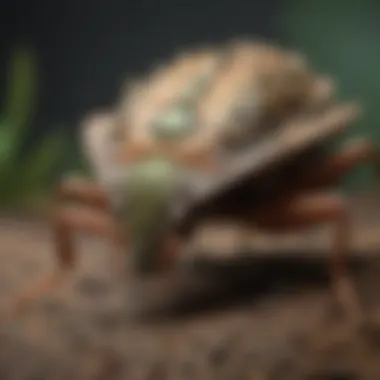
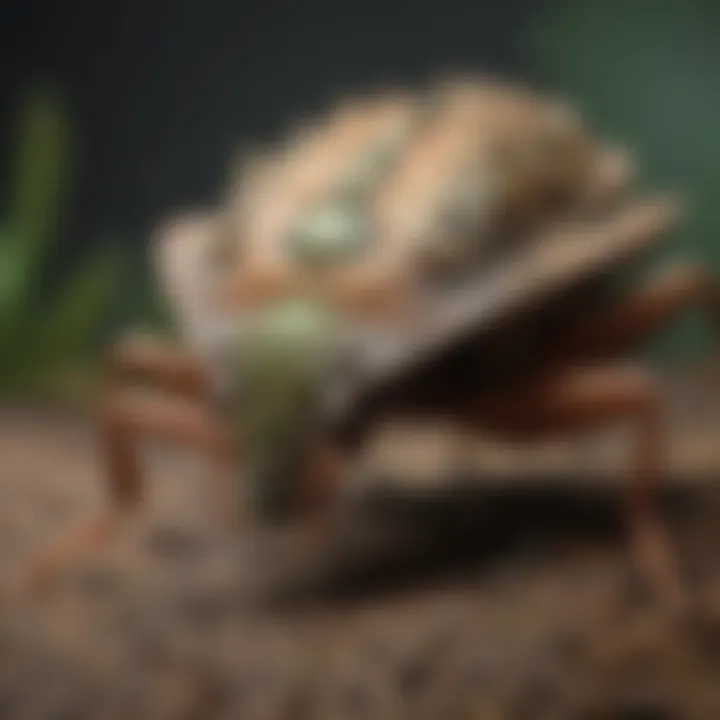
Chemical controls encompass the use of insecticides specifically designed to target stink bugs. They are a crucial aspect of management, especially when infestations escalate beyond manageable levels.
Insecticides
The use of insecticides plays a vital role in controlling stink bug populations. These chemicals can effectively reduce pest populations and protect crops from significant damage. One notable aspect of insecticides is their targeted action, allowing for specific application against stink bugs without harming beneficial insects when used properly.
However, the use of insecticides can lead to concerns about resistance development in pest populations and potential environmental impacts. Thus, they should be employed judiciously and in conjunction with other control strategies.
Safety Precautions
When using insecticides, safety precautions are essential to ensure the well-being of the applicator and the surrounding environment. Proper handling, application instructions, and protective gear must be adhered to. One of the central aspects of safety precautions is readability of labels, ensuring that those applying the chemicals understand usage guidelines clearly.
Following safety guidelines not only protects farmers and their families but also minimizes potential runoff into water sources, reducing environmental risks. Emphasizing safety when using insecticides ensures that management strategies remain effective and sustainable in the long run.
The integration of comprehensive management strategies is essential for effective stink bug control, balancing the need for pest reduction with environmental considerations.
Impact of Climate Change
Climate change is becoming a significant factor in many biological and ecological studies. Understanding the impacts of climate change on stink bugs is crucial for effective management strategies. As environmental conditions shift, so do the patterns of pest behavior, distribution, and population dynamics. This section will explore how these changes effect stink bug populations, influencing agricultural practices and pest control measures.
Effects on Distribution
Shifts in temperature and precipitation patterns can alter the geographical distribution of stink bugs. Warmer temperatures may allow pests to expand their range into new regions previously unsuitable for them.
- Migration Patterns: Stink bugs may migrate to higher latitudes or elevations, following the climate that better suits their survival.
- Habitat Suitability: When temperatures rise, some areas may no longer be hospitable to stink bugs, while others become more favorable. This leads to altered population densities in different regions.
- Seasonal Activity: Changes in climate also shift life cycles. For instance, earlier springs result in earlier egg laying, creating generations that may overlap more. This can exacerbate infestations.
The northward movement of certain species has already been observed, highlighting the necessity to adapt pest management strategies accordingly. Farmers must stay informed about these shifts to mitigate potential crop damage.
Changing Behavior Patterns
The behavioral adaptations of stink bugs due to climate change are equally significant. These shifts can impact their feeding habits, reproduction, and overall ecological interactions.
- Altered Feeding Habits: Changes in plant growth cycles may affect stink bugs' food availability. As temperature changes, crops may mature earlier or later, impacting the timing of stink bug infestations.
- Mating Timing: Warmer conditions may influence mating rituals. Stink bugs might alter their reproductive timing, leading to increased competition for resources and mates.
- Predator-Prey Dynamics: With changes to their behavior, stink bugs may also impact their predators. The imbalance may create challenges for natural control in agricultural settings.
Understanding these behavioral changes can help farmers predict and manage stink bug populations more effectively, adapting strategies as needed.
In summary, climate change has multifaceted effects on stink bugs. Their distribution and behavior directly influence agricultural practices and pest management. Awareness of these changing patterns is essential for successful agricultural outcomes.
Future Research Directions
Research on stink bugs is evolving as these pests continue to pose significant challenges in agricultural and ecological contexts. Understanding future research directions can lead to better management practices, more effective controls, and insights into ecological balance.
Advancements in technology and methodologies are crucial for enhancing our knowledge about stink bugs. Additional focus is needed on their behavioral adaptations, responses to climate change, and impacts on various ecosystems. By identifying gaps in existing literature, researchers can prioritize studies that provide vital data for farmers and pest managers.
Emerging Trends in Stink Bug Study
Recent studies highlight several emerging trends in the research of stink bugs. One prominent trend is the application of molecular techniques to understand the genetic makeup of different species. This genetic understanding can pave the way for identifying species-specific management strategies, customized to the particular behaviors or weaknesses of each species.
Moreover, researchers are increasingly looking at the use of technology such as remote sensing and geographic information systems (GIS). These technologies can help predict stink bug distribution and population dynamics based on environmental conditions. Understanding these patterns can inform timing for pest control measures, making them more effective.
Another key trend is interdisciplinary collaboration. Fields such as entomology, ecology, and agriculture are beginning to overlap, creating a more holistic view of stink bug impacts. This approach can lead to more comprehensive management strategies and a better understanding of stink bugs' roles in ecosystems.
"Emphasizing multidimensional approaches in research enables us to grasp the intricate interactions in ecosystems where stink bugs reside."
Innovations in Management Techniques
Innovations in managing stink bug populations are essential to ensure sustainable agricultural practices. Current trends indicate a move towards integrated pest management (IPM) strategies that blend biological, cultural, and physical control methods. For example, the use of natural predators or parasitoids is being explored as a biologically based control method. These solutions can provide sustainable alternatives to chemical controls, effectively reducing stink bug populations without harming beneficial insects.
Additionally, there is ongoing research into the development of new insecticides with reduced environmental impact. Researchers aim to formulate chemicals that target stink bugs specifically while preserving other vital species within the ecosystem. This targeted approach minimizes potential side effects on non-target organisms.
Participatory research has also gained attention. Engaging farmers in the research process not only enhances knowledge transfer but also empowers them to adopt new management practices confidently. Farmers can provide valuable insight into pest behaviors and effectiveness of various management strategies, which can lead to more practical and farmer-friendly solutions.
Overall, future research directions concerning stink bugs emphasize the need for innovative, sustainable pest management practices that take into account the complexities of agricultural systems and ecological interactions.
Culmination
The conclusion of this article serves as a crucial synthesis of the key information regarding stink bugs and the myriad issues they present to agriculture and ecosystems. It wraps up the analysis by reaffirming the significance of understanding stink bugs, not just as pests but as an integral part of the agricultural landscape. This understanding can enable farmers and enthusiasts to incorporate effective strategies into their management plans.
Summary of Key Points
In reviewing the main points, several aspects stand out:
- Biological Characteristics: Stink bugs have diverse features and lifecycles that influence their behaviors. Knowing these allows for better identification and control.
- Behavioral Patterns: Their feeding habits and mating rituals can affect crop yields. This connection to agriculture underscores the need for awareness.
- Ecological Impact: Understanding their role in the ecosystem is vital. They can be both beneficial and harmful, serving as both predators and pests.
- Management Strategies: Effective management involves combining preventive and control measures. Recognizing the importance of cultural, mechanical, and chemical controls is essential.
- Climate Change Effects: Observing how changing climates impact stink bug distribution and behavior helps predict future agricultural challenges.
- Future Research Directions: Ongoing studies aim to improve management techniques and understand emerging trends.
Implications for Agriculture
The implications of stink bugs extend well beyond simple pest identification. These creatures directly affect agricultural productivity through their feeding habits, leading to significant crop damage. Farmers must recognize that proactive measures are key to minimizing these effects.
They should consider adopting an integrated pest management approach, which includes:
- Monitoring populations to determine thresholds for action.
- Promoting biodiversity on farms, which may aid in naturally regulating stink bug populations through predation.
- Education on identification to distinguish harmful species from beneficial ones.



